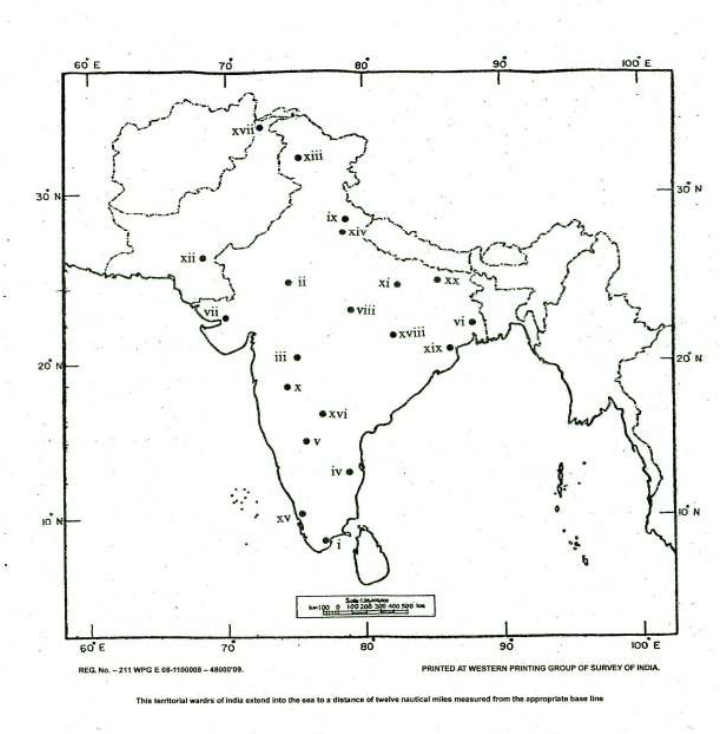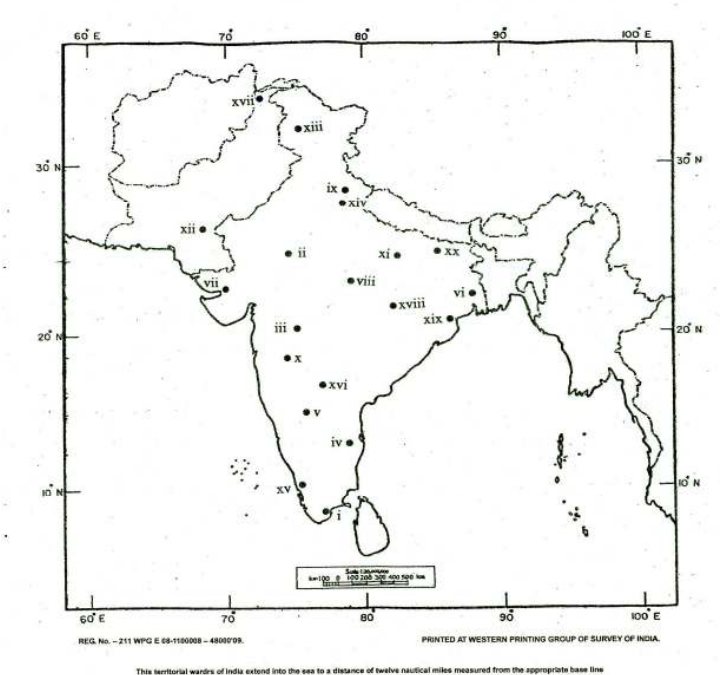UPSC IAS (Mains) 2018 History Optional (Paper -1) Exam Question Paper in Hindi | यूपीएससी आईएएस 2018 (मुख्य परीक्षा) इतिहास वैकल्पिक पेपर -1 | History Optional Previous Year Question Paper-1 2018
History Optional Previous Year Question Paper-1 2018
1. आपको दिए गए मानचित्र पर अंकित निम्नलिखित स्थानों की पहचान कीजिए एवं अपनी प्रश्न सह उत्तर पुस्तिका में उनमें से प्रत्येक पर लगभग 30 शब्दों की संक्षिप्त टिप्पणी लिखिये मानचित्र पर अंकित प्रत्येक स्थान के लिए स्थान निर्धारण संकेत क्रमानुसार भीचे दिए गए हैं।
Identify the following places marked on the map supplied to you and write a short note of about 30 words on each of them in your Question-cum-Answer Booklet. Locational hints for each of the places marked on the map are given below seriatim 50
(i) महापाषाणीय भूनिवेश स्थल Megalithic burial site
(ii) ताम्रपाषाणीय स्थल Chalcolithic site
(iii) गुहाचित्र Cave paintings
(iv) पुरापाषाणकालीन स्थल Paleolithic site
(v) राजनीतिक एवं सांस्कृतिक केन्द्र Political and Cultural centre
(vi) पक्व मृत्तिका केन्द्र Terracotta centre
(vii) हड़प्पाकालीन स्थल Harappan site
(viii) वैष्णव सांस्कृतिक स्थल Vaishnava cultural site
(ix) चित्रित धूसर मृदभांड स्थल Painted Grey Ware site
(x) ताम्रपाषाणीय स्थल Chalcolithic site
(xi) आरम्भिक कृषि केन्द्र Early agricultural centre
(xii) आरम्भिक हडप्पाकालीन स्थल Early Harappan site
(xiii) एक प्राचीन मन्दिर An ancient temple
(xiv) राजनीतिक एवं सांस्कृतिक केन्द्र Political and Cultural centre
(xv) एक प्राचीन समुद्री बन्दरगाह An ancient sea port
(xvi) बौद्ध केन्द्र Buddhist centre
(xvii) अभिलेखन स्थल Inscriptional site
(xviii) एक प्राचीन राजधानी An ancient capital
(xix) एक जैन केन्द्र A Jaina centre
(xx) एक प्राचीन राजधानी An ancient capital

2.(a) आरम्भिक भारतीय ऐतिहासिक परम्परा, जैसी कि वह इतिहास पुराण से प्रतिविम्बित है, किस प्रकार प्रकट हुई थी ? इस शैली के विशिष्ट अभिलक्षण क्या है ?
How did the early Indian historical tradition, as reflected in Itihasa-Purana, emerge? What are the distinctive features of this genre?
2.(b) “पुरातत्वीय साक्ष्य हड़प्पा सभ्यता के पतन के सम्भावित सामाजिक और राजनीतिक आयामों का प्रत्यक्ष पता तो नहीं देते हैं। वे यह तो बहुत स्पष्ट रूप से इंगित करते हैं कि हड़प्पा संस्कृति वि-नगरीकरण के क्रमिक प्रक्रम में से गुजरी थी।” टीका कीजिए।
“Archaeological evidence does not give direct access to the possible social and political dimensions of the decline of the Harappan civilization. What it does indicate very clearly is that the Harappan culture underwent a gradual process of deurbanization” ? Comment.
2.(c) गण संघों (गैर-राजतंत्रीय राज्य प्रणालियां) का विवरण प्रस्तुत कीजिए। उनका पतन किस कारण हुआ था ?
Give an account of gana-sanghas (non-monarchical state systerns)? Why did they decline?
3.(a) क्या आप इस लोक प्रचलित मत से सहमत है कि मोर्यो ने यदि एकाश्मक राज्य तंत्र नहीं, तो भी एकात्मक और अत्यधिक केन्द्रित राज्य प्रणाली की स्थापना की थी ?
Do you agree with the popular view that Mauryas established a unitary and highly centralized if not monolithic state system?
3.(b) श्रमानिक धर्मों की संकल्पना के मूल, बौद्ध-धर्म के विशेष संदर्भ में, उपनिषदीय विचारों में थे। विवेचना कीजिए। The concept of Shramanic religions, with particular reference to Buddhism, had their roots in Upanisadic ideas. Discuss,
3.(c) “निसंदेह यह एक स्वतंत्र राज्य नहीं था येन-केन प्रकारेण यह एक राज्य था (के ए एन शास्त्री) चोला देश में स्थानीय स्वशासन संस्थाओं की प्रकृति पर विचार व्यक्त कीजिए ।
“Doubtless it was not a free state; it was any rate a state” (KAN Sastri). Reflect upon the nature of local self government institutions in the Chola country.
4.(a) उत्तर मौर्य काल में प्रदेश-पारीय और महाद्वीप पारीय व्यापार का भारत के सामाजिक और सांस्कृतिक जीवन पर क्या प्रभाव पड़ा था ?
What was the impact of trans-regional and trans-continental trade in the post Mauryan period on social and cultural life of India?
4. (b) “उत्पन्ना द्रबिड़े भक्तिः कर्णाट वृद्धिमागता ।
स्थिता किंचित् महाराष्ट्रे गुजरे जीर्णतां गता ।’
——– पद्मपुराण
‘द्राविड़ देश’ में भक्ति के आविर्भाव का विवरण दीजिए।
Utpanna dravide bhaktih, Karnate vriddhimagata
Sthitä kinchit mahäräshtre gurjare jirnatām gata ” — Padmapurana
Account for the emergence of bhakti in Dravida desa.
4.(c) गुप्ता-माकाटका काल के दौरान में कता और बास्तुकला संबंधी प्रयोगों पर चर्चा कीजिए
Discuss the experimentations with art and architecture during the Gupta-Vakataka period. 15
खण्ड ‘B’
SECTION ‘B’
निम्नलिखित में से प्रत्येक प्रश्न का उत्तर लगभग 150 शब्दों में दीजिए:
Answer the following questions in about 150 words each:
10×5-50
5.(a) “टारेन और चंदावर की लड़ाइयों ने भारत में तुर्की शासन की नींव रखी थी” विस्तारपूर्वक स्पष्ट कीजिए।
“The battles of Tarain and Chandawar laid the foundations of Turkish rule in India”. Elaborate. 10
5 (b ) महिला दासों के विशेष उल्लेख के साथ, इब्न बतूता द्वारा दास प्रथा पर दिए गए साक्ष्य की विवेचना
कीजिए ।
Discuss evidence on slavery provided by Ibn Batuta with special reference to female slaves. 10
5.(c) दिल्ली सुल्तानों के अधीन वस्त्र प्रौद्योगिकी में हुई उन्नति की विवेचना कीजिए।
Discuss the advancement made in Textile Technology under the Delhi Sultans. 10
5.(d) “अकबर ईश्वर में अपने दृढ़ विश्वास को बलपूर्वक कहना चाहता था, परंतु ईश्वर की पूजा किस ढंग से की जाय इस संबंध में उसकी संकल्पना कट्टर इस्लाम वा कट्टर हिन्दुत्व से स्वतंत्र थी।” टिप्पणी कीजिए
“Akbar wished to assert his strong belief in God, but his concept of the way God is to be worshipped was independent of either orthodox Islam or Hinduism”. Comment.
5.(e) मुगल भारत में, हिन्दी में लिखे गए साहित्य का विवेचन कीजिए ।
Discuss the literature written in Hindi in Mughal India.
6.(a) आरम्भिक मध्य कालीन अवधि के दौरान जाति की और स्त्री-पुरुष संबंधों की बदलती हुई प्रकृति का समालोचनात्मक विश्लेषण कीजिए।
Critically analyze the changing nature of caste and gender relations during the early medieval period. 15
6.(b) “मुगल भारत में कृषि का एक महत्वपूर्ण अभिलक्षण किसानों द्वारा बड़ी संख्या में फसलें उगाना था”। उदाहरण देते हुए, स्पष्ट कीजिए।
“An important feature of agriculture in Mughal India has been the large number of crops raised by the peasants”. Illustrate by giving examples. 15
6.(c) “मुहम्मद तुगलक द्वारा विषमांग अमीरवर्ग के निर्माण की नीति ने दिल्ली सल्तनत के विखण्डन का प्रक्रम प्रारम्भ कर दिया था” व्याख्या कीजिए।
“The policy of creating heterogeneous nobility by Muhammad Tughluq started the process of disintegration of Delhi Sultanate”. Explain. 20
7.(a) क्या आप सहमत हैं कि प्रायद्वीपीय भारत में राजनीतिक शून्य और इस्लामियत संस्कृति और राज्य व्यवस्था का प्रभाव विजयनगर राज्य की संवृद्धि का एक बड़ा कारण था ?
Do you agree that convergence of political vacuum and impact of Islamicate culture and polity in peninsular India has much to do with the growth of Vijayanagara kingdom?
(7.(b) भारत में, मकबरों के निर्माण में आनुक्रमिक सुल्तानों द्वारा जोड़े गए वास्तुकलात्मक अभिलक्षणों का वर्णन कीजिए।
Describe the new architectural features added by successive Sultans in the construction of Tombs in India.
7.(c) सामान्य रूप से भारत में और विशेषकर दक्कन में, इस्लाम के फैलाव में, सूफी लोक साहित्य की क्या भूमिका थी?
What was the role of Sufi Folk literature in the diffusion of Islam in India in general and in Deccan in particular.
8 (a ) मुगल शासकों के अधीन जमींदारी व्यवस्था की कार्य प्रणाली का विवेचन कीजिए। साथ ही मुगल भारत की कृषिभूमि संबंधी अर्थ व्यवस्था में जमींदारों द्वारा निबाही गयी भूमिका का भी वर्णन कीजिए।
Discuss the working of Zamindari System under the Mughal rulers. Also describe the role played by the Zamindars in the agrarian economy of Mughal India. 20
8.(b) “शाहजहां के अधीन भवन निर्माण कला को पराकाष्ठा की उच्चतम अवस्था तक ले जाया गया था”। उसकी सर्वाधिक प्रख्यात इमारतों में से दो के वास्तुकलात्मक ब्यौरे देते हुए यह सुस्पष्ट कीजिए
“The art of building was carried to highest degree of perfection under Shahjahan”. Illustrate by giving architectural details of two of his most celebrated buildings.
8.(c) “18 वीं शताब्दी में, अफग़ान आक्रमणों ने मुगल साम्राज्य की सैनिक अप्रासंगिकता को ही केवल उजागर ही नहीं किया, बल्कि इसके पतन को भी दुत कर दिया था” स्पष्ट कीजिए।
“The Afghan invasions in the Eighteenth Century not only signified the military irrelevance of the Mughal Empire but also hastened its decline”. Explain. 15
History Optional Previous Year Question Paper-1 2018
Read Also-
HKT TEAM
HKT TEAM का लक्ष्य हिंदी भाषा में रिसर्च करके सरल से सरल तरीके से ज्ञान वर्धक कंटेंट उपलब्ध कराना तो है ही साथ ही युवाओ के व्यक्तित्व के बहुमुखी विकास हेतु अनेक महत्वपूर्ण विषयो पर ( जैसे की व्यक्तित्व विकास , प्रोत्साहन आदि ) लेख के माध्यम से मार्गदर्शन भी प्रदान करना हैं।


